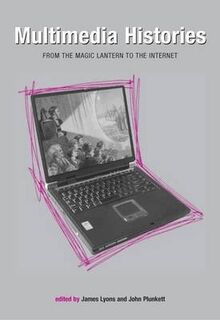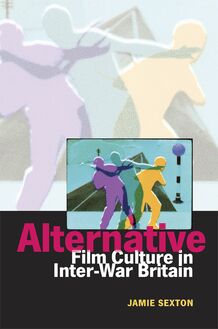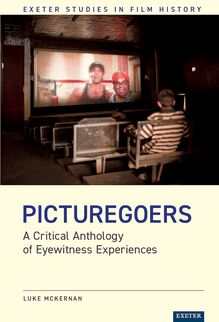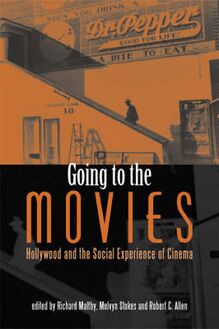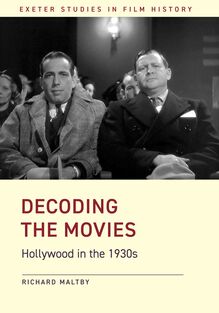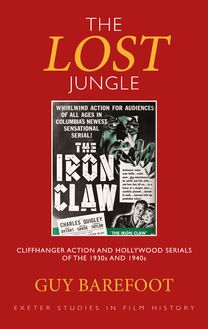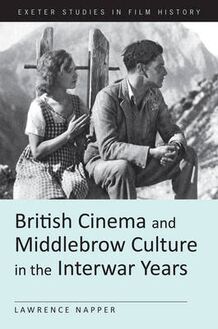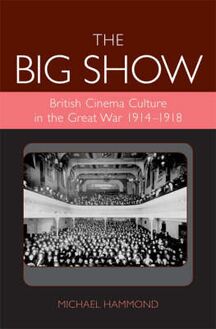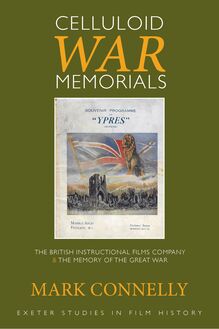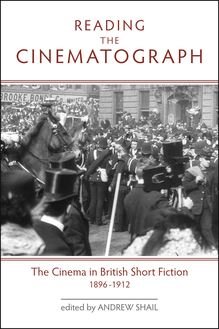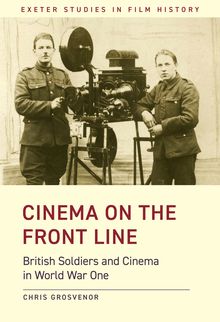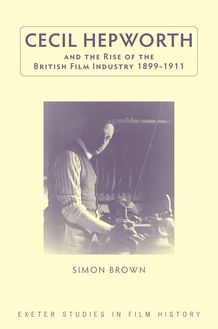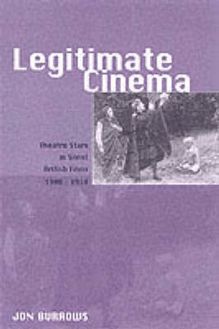-
 Univers
Univers
-
 Ebooks
Ebooks
-
 Livres audio
Livres audio
-
 Presse
Presse
-
 Podcasts
Podcasts
-
 BD
BD
-
 Documents
Documents
-
- Cours
- Révisions
- Ressources pédagogiques
- Sciences de l’éducation
- Manuels scolaires
- Langues
- Travaux de classe
- Annales de BEP
- Etudes supérieures
- Maternelle et primaire
- Fiches de lecture
- Orientation scolaire
- Méthodologie
- Corrigés de devoir
- Annales d’examens et concours
- Annales du bac
- Annales du brevet
- Rapports de stage
La lecture à portée de main
Découvre YouScribe en t'inscrivant gratuitement
Je m'inscrisBritish Cinema and Middlebrow Culture in the Interwar Years , livre ebook
Découvre YouScribe en t'inscrivant gratuitement
Je m'inscrisEn savoir plus
En savoir plus

Description
British Cinema and Middlebrow Culture in the Interwar Years offers an understanding of British Cinema between 1928 and 1939 through an analysis of the relationship between the British film industry and other ‘culture industries’ such as the radio, music recording, publishing and early television.
This relationship has been seen as a weakness of the British film-making tradition, but Lawrence Napper stages a re-appraisal of that tradition, arguing that it is part of a specific strategy of differentiation from Hollywood cinema, designed to appeal to the ‘middlebrow’ aesthetic of the most rapidly expanding audience of the period—the lower middle class.
Lawrence Napper argues that the ‘middlebrow’ reputation for aesthetic conservatism masks an audience and popular culture marked by dynamism. ‘Middlebrow’ texts addressed a British audience on the move, physically (into the new suburbs), socially (as upwardly mobile consumers), economically (employed in new and developing industries, and involved in new modes of living), and culturally (embracing new forms of mass cultural consumption, such as the cinema, the wireless and the best-selling novel). The ability of these audiences to adapt cultures of the past to the media of modern life (through stage or screen adaptations) ensured their negative reputation amongst Modernist commentators and intellectual elites.
List of Illustrations
Preface and Acknowledgements
Introduction: The 'Middlebrow' Concept of the National: Music Hath Charms 1935
1. A Law for British Film: The Cinematography Films Act 1927
2. British Cinema, The Publishing Industry and the Mass Market: The Constant Nymph 1924-1928
3. The 'Middlebrow' Debate and Film: The Good Companions 1929-1933
4. New and Old Cultures: The Lambeth Walk 1937-1939
Conclusion: The Viability of National Cinema
Notes
Bibliography
Index
Sujets
Musique
Culture musicale
Business Aspects
Social History
Media Studies
20th Century
Industries
Modern
HISTORY
Histoire
MUSIC
Reino Unido
Película fotográfica
Multiple signal classification
Music industry
Interwar period
Modern history
General officer
Ireland
Publishing
Cultural studies
United Kingdom
History of Europe
Cinema of the United Kingdom
History of film
Entertainment
British Isles
Anthropology
Stephen Ireland
Great Britain
General
Radio
Obermodern-Zutzendorf
Film
Industrie
Royaume-Uni
Media
Europe
Informations
| Publié par | University of Exeter Press |
| Date de parution | 02 mars 2015 |
| Nombre de lectures | 0 |
| EAN13 | 9780859899017 |
| Langue | English |
| Poids de l'ouvrage | 2 Mo |
Informations légales : prix de location à la page 0,5625€. Cette information est donnée uniquement à titre indicatif conformément à la législation en vigueur.
Extrait
Britsh Cinema and Middlebrow
Culture in the Interwar Years
EXETER STUDIES IN FILM HISTOR Y EXETER STUDIES IN FILM HISTOR Y
Britsh Cinema and Middlebrow Culture in
the Interwar Years ofers an understanding of
Britsh Cinema between 1928 and 1939 through
Lawrence Napper is a lecturer in Film Studies at the the relatonship between the Britsh flm
University of Greenwich; he was senior researcher Britsh Cinema and
industry and other ‘culture industries’ such as
on the Britsh Cinema History Research Project for
the radio, music recording, publishing and early
four years at the University of East Anglia. Middlebrow Culture television. This relatonship has traditonally
been seen as a weakness of the Britsh
flmin the Interwar Years making traditon, but this book stages a
re-appraisal of that traditon, arguing that it
LAWREN CE N APPER is part of a specifc strategy of diferentaton
from Hollywood cinema, designed to appeal to
Through a fresh analysis of the relatonship the ‘middlebrow’ aesthetc of the most rapidly
between the Britsh flm industry and such expanding audience of the period—the lower
culture industries as radio, music recording, middle class.
publishing and early television, this book
re-evaluates the history of Britsh cinema Lawrence Napper argues that the ‘middlebrow’
and culture between 1928 and 1939. reputaton for aesthetc conservatsm conceals
an audience and popular culture marked by
Lawrence Napper stages a reappraisal
dynamism. ‘Middlebrow’ texts addressed a
of the Britsh flmmaking traditon in the
Britsh audience on the move, physically (into
interwar period. He argues that flmmaking
the new suburbs), socially (as upwardly mobile
in the period followed a specifc strategy
consumers), economically (employed in new of diferentaton from Hollywood cinema,
and developing industries, and involved in new designed to appeal to the ‘middlebrow’
modes of living), and culturally (embracing new aesthetc of the most rapidly expanding
forms of mass cultural consumpton, such as the audience—the lower middle class.
cinema, the wireless and the best-selling novel). Britsh Cinema and
The ability of these audiences to adapt cultures
of the past to the media of modern life—their
very assumpton that it was possible to translate
NAPPER Middlebrow Culture
A complete list of ttles published is available from: cultural capital unproblematcally across media,
University of Exeter Press through stage or screen adaptatons—ensured
Reed Hall
their negatve reputaton amongst Modernist Streatham Drive in the Interwar YearsExeter commentators and intellectual elites more
EX4 4QR
concerned with textual and cultural purity.
UK
www.exeterpress.co.uk
Jacket photograph: Ivor Novello and Mabel Poulton
ISBN 978 0 85989 797 6in Gainsborough Pictures’ ‘The Constant Nymph’ (1927),
courtesy of the Ronald Grant Archive UNIVERSITY OF EXETER PRESS LAWREN CE N APPER
Jacket design: Betna Newman www.exeterpress.co.ukBritish Cinema and Middlebrow
Culture in the Interwar Years
Through a fresh analysis of the relationship between the British film
industry and such culture industries as radio, music recording, publishing
and early television, this book re-evaluates the history of British cinema and
culture between and 1939.
Lawrence Napper stages a reappraisal of the British filmmaking
tradition in the interwar period. He argues that filmmaking in the period
followed a specific strategy of differentiation from Hollywood cinema,
designed to appeal to the ‘middlebrow’ aesthetic of the most rapidly
expanding audience—the lower middle class.
Lawrence Napper is a lecturer in Film Studies at Kings College, London; he was
senior researcher on the British Cinema History Research Project for four years at
the University of East Anglia.
1928Exeter Studies in Film History
Published by University of Exeter Press in association with the Bill Douglas Centre
for the History of Cinema and Popular Culture
Series Editors: Richard Maltby, Professor of Screen Studies, Flinders University,
South Australia and Steve Neale, Professor of Film Studies and Academic Director
of the Bill Douglas Centre, University of Exeter
Parallel Tracks: The Railroad and Silent Cinema
Lynne Kirby (1997)
The World According to Hollywood, 1918–1939
Ruth Vasey (1997)
‘Film Europe’ and ‘Film America’: Cinema, Commerce and Cultural Exchange 1920–1939
edited by Andrew Higson and Richard Maltby (1999)
A Paul Rotha Reader
edited by Duncan Petrie and Robert Kruger (1999)
A Chorus of Raspberries: British Film Comedy 1929–1939
David Sutton ()
The Great Art of Light and Shadow: Archaeology of the Cinema
Laurent Mannoni, translated by Richard Crangle ()
Popular Filmgoing in 1930s Britain: A Choice of Pleasures
John Sedgwick ()
Alternative Empires: European Modernist Cinemas and Cultures of Imperialism
Martin Stollery ()
Hollywood, Westerns and the 1930s: The Lost Trail
Peter Stanfield ( )
Young and Innocent? The Cinema in Britain 1896–1930
edited by Andrew Higson ()
Legitimate Cinema: Theatre Stars in Silent British Films –1918
Jon Burrows ( )
The Big Show: British Cinema Culture in the Great War (1914–1918)
Michael Hammond ( )
Multimedia Histories: From the Magic Lantern to the Internet
edited by James Lyons and John Plunkett ()
Going to the Movies: Hollywood and the Social Experience of Cinema
edited by Richard Maltby, Melvyn Stokes and Robert C. Allen ()
Alternative Film Culture in Inter-War Britain
Jamie Sexton ()
Marketing Modernity: Victorian Popular Shows and Early Cinema
Joe Kember ( )
UEP also publishes the celebrated five-volume series looking at the early years of
English cinema, The Beginnings of the Cinema in England, by John Barnes.
2009
2008
2007
2007
2006
2003
1908
2002
2001
2000
2000
2000
2000The Good Companions (1933)—A new society is formed
The worst of Mr Rotha, as of all highbrow writers about the cinema, is
that he will not recognise what I should like to call the half-way film¬
I am persuaded that what the average intelligent cinema-goer likes is
something half-way between the Caligari stuff in which people look like
parallelograms and furniture in rhomboid, and the nit-wit film in which
stenographers renounce diamonds and protection for the horny-handed
wistfulness of some virginal cow-puncher. Most cinema-goers, I am
persuaded, just want a reasonably good story reasonably well told.
James Agate, 1930.British Cinema and Middlebrow
Culture in the Interwar Years
Lawrence NapperFirst published in by
University of Exeter Press
Reed Hall, Streatham Drive
Exeter ex4 4qr
UK
www.exeterpress.co.uk
© Lawrence Napper
The right of Lawrence Napper to be identified as author of this
work has been asserted by him in accordance with
the Copyright, Designs and Patents Acts .
British Library Cataloguing in Publication Data
A catalogue record for this book is available
from the British Library.
ISBN 978 0 85989 797 6
Typeset in Caslon
by XL Publishing Services, Tiverton
Printed in Great Britain by Short Run Press Ltd., Exeter
1988
2009
2009Contents
List of Illustrations viii
Preface and Acknowledgements ix
Introduction: The ‘Middlebrow’ concept of the National:
Music Hath Charms 1935 1
1. A Law for British Film: The Cinematograph Films Act
2. British Cinema, The Publishing Industry and the Mass Market:
The Constant Nymph -
3. The ‘Middlebrow’ Debate and Film:
The Good Companions –
4. New and Old Cultures: The Lambeth Walk 1937-1939 131
Conclusion: The Viability of National Cinema 195
Notes
Bibliography
Index
235
227
209
81 1933 1929
35 1928 1924
17 1927Illustrations
Frontispiece: The Good Companions (1933)—A new society is formed iv
2 Henry Hall sorts his fan-mail in Music Hath Charms (1935)x
3 The Western Electric—new technology masquerading as tradition 10
4 Picture Show souvenir of The Constant Nymph, 6 October
5-8 Stoll Advertisement for the ‘Eminent British Authors’ Series
(Kinematograph Weekly, 14 October ) 63–6
9 The Good Companions (1933)
10 Doing the ‘Lambeth Walk’—Lupino Lane and Teddie St Dennis
on the stage of the Victoria Palace Theatre, 1937 130
11 Odo-ro-no—advertising to the aspirant worker (Film Weekly,
1 February 1936)
12 ‘Television Is Here’—advertisement produced by the Radio
Manufacturer’s Association, August 1939 163
13-15 Televising Me and My Girl at the Victoria Palace 165, 168, 169
16 Doing the ‘Lambeth Walk’ for Picture Post,
17 Miss Dipper and Billy Pearce do the ‘Lambeth Walk’
179
178 1938
143
80
1920
34 1928Preface and Acknowledgements
This book began life as a PhD thesis which I completed at the University of
East Anglia in . My studies were fully funded by the Arts and
Humanities Research Board and I gratefully acknowledge their assistance here. I would
also like to thank Professor Andrew Higson who was the supervisor of the
original thesis. Other colleagues who provided invaluable help and insightful
comments include Charles Barr, Jane Bryan, Jon Burrows, Pam Cook, Al
Cormack, Christine Gledhill, Jenny Hammerton, Jayne Morgan, Robert
Murphy, Yvonne Tasker, Sadie Wearing and Michael Williams. For the kind
provision of resources I would like to thank Janet Moat at the BFI Special
Collections Unit, Mike Bott at the Publishers Archive at Reading
University, Luke McKernan at the BUFVC, Simon Vaughan of the Alexandra
Palace Television Society, Kevin Brownlow, Jenny Hammerton at British
Pathé PLC, Laraine Porter, Bryony Dixon at the BFI Viewing Service, Staff
at the Mass-Observation Archive at Sussex University Library, and Sarah Street.
For help during the long process of converting the thesis into a book, I
would like to acknowledge Simon Baker at the University of Exeter Press,
Martin Humphries at the Ronald Grant Picture Library, Hulton Getty
Picture Library, Jon Burrows, Steve Neale, Richard Maltby, Nathalie
Morris, Amy Sargeant and Mark Jeanes.
Some of the material from Chapter 3 appeared as ‘British Cinema and the
Middlebrow’ in Justine Ashby and Andrew Higson (eds), British Cinema:
Past and Present (London: Routledge,
-
 Univers
Univers
-
 Ebooks
Ebooks
-
 Livres audio
Livres audio
-
 Presse
Presse
-
 Podcasts
Podcasts
-
 BD
BD
-
 Documents
Documents
-
Jeunesse
-
Littérature
-
Ressources professionnelles
-
Santé et bien-être
-
Savoirs
-
Education
-
Loisirs et hobbies
-
Art, musique et cinéma
-
Actualité et débat de société
-
Jeunesse
-
Littérature
-
Ressources professionnelles
-
Santé et bien-être
-
Savoirs
-
Education
-
Loisirs et hobbies
-
Art, musique et cinéma
-
Actualité et débat de société
-
Actualités
-
Lifestyle
-
Presse jeunesse
-
Presse professionnelle
-
Pratique
-
Presse sportive
-
Presse internationale
-
Culture & Médias
-
Action et Aventures
-
Science-fiction et Fantasy
-
Société
-
Jeunesse
-
Littérature
-
Ressources professionnelles
-
Santé et bien-être
-
Savoirs
-
Education
-
Loisirs et hobbies
-
Art, musique et cinéma
-
Actualité et débat de société
- Cours
- Révisions
- Ressources pédagogiques
- Sciences de l’éducation
- Manuels scolaires
- Langues
- Travaux de classe
- Annales de BEP
- Etudes supérieures
- Maternelle et primaire
- Fiches de lecture
- Orientation scolaire
- Méthodologie
- Corrigés de devoir
- Annales d’examens et concours
- Annales du bac
- Annales du brevet
- Rapports de stage
